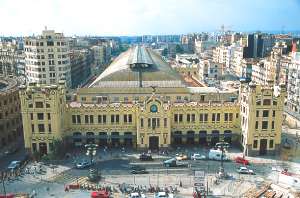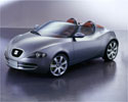
Conference Location
History
 The city of Valencia, original Latin name of which, was Valentia (/wa'lentia/), meaning "Strength", "Vigor", the city being named after Emperor Valens, who ordered the foundation of a new colony in Hispania, is in the region known in ancient days as Edetania. The Roman historian Florus says that Junius Brutus, transferred there (140 BC) the soldiers who had fought under him. Later it was a Roman military colony. In punishment for its adherence to Sertorius it was destroyed by Pompey, but was later rebuilt, and Pomponius Mela says that it was one of the principal cities of Hispania Tarraconensis province. The city was founded by the Romans in 137 BC on the site of a former Iberian town, by the river Turia.
The city of Valencia, original Latin name of which, was Valentia (/wa'lentia/), meaning "Strength", "Vigor", the city being named after Emperor Valens, who ordered the foundation of a new colony in Hispania, is in the region known in ancient days as Edetania. The Roman historian Florus says that Junius Brutus, transferred there (140 BC) the soldiers who had fought under him. Later it was a Roman military colony. In punishment for its adherence to Sertorius it was destroyed by Pompey, but was later rebuilt, and Pomponius Mela says that it was one of the principal cities of Hispania Tarraconensis province. The city was founded by the Romans in 137 BC on the site of a former Iberian town, by the river Turia.

|
During the rule of the Muslim Empires in Spain, it was known as بلنسية Balansiya) in Arabic. They occupied the territory peacefully in 709 A.D. When Islamic culture settled in Valencia - then Balansiya - it prospered thanks to a booming trade in paper, silk, leather, ceramics, glass and silver-work. The architectural legacy from this period is abundant in Valencia and can still be appreciated today in the remains of the old walls, the Baños del Almirante bath house, Portal de Valldigna street and even the Cathedral and the tower, El Micalet, which was the minaret of the old mosque. |
|

|
After the death of Almanzor and the unrest that followed 'the Cid' conquered Valencia for a short period on 15 June 1094 - July 1099. He turned nine mosques into churches, and installed as bishop the French monk Jérôme (this victory was immortalised in the Lay of the Cid). On the death of the Cid (July 1099), his wife, Doña Ximena, retained power for two years, when Valencia was besieged by the Almoravids, and the city returned to the Almoravids in 1102. Although the 'Emperor of Spain' Alfonso drove them from the city, he was not strong enough to hold it. The Christians set fire to it, abandoned it, and the Almoravid Masdali took possession of it on 5 May 1109. The event was commemorated in a poem by Ibn Khafaja in which he thanked Yusuf ibn Tashfin for the liberation of the city. The Almoravid and the Almohad dynasty would rule Valencia for more than a century. |
|
In 1238 King James I of Aragon the Conqueror, with an army composed of French, English, Germans, and Italians, laid siege to Valencia, and on 28 September in that same year forced a surrender. 50,000 Moors were forced to leave. Poets like Ibn al-Abbar and Ibn Amira mourned their exile from their beloved Valencia. On 9 October king James, followed by his retinue and army, took possession. The principal mosque was purified, Mass was celebrated, and the "Te Deum" sung. James incorporated city and territory into the new formed Kingdom of Valencia, one of the kingdoms forming the Crown of Aragon.
|
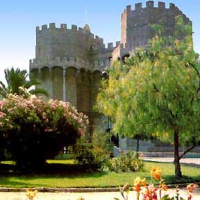
|

|
Catholic sources tell that Saint Vincent Ferrer preached so successfully (sometime between 1390 and 1411), converting thousands of Jews, that he was permitted to employ the synagogue for his newly-founded hospital of San Salvador. In the 15th and 16th centuries, Valencia was one of the major cities in the Mediterranean. The writer Joanot Martorell, author of Tirant lo Blanch, and the poet Ausias March are famous Valencians of that era. |
|
During the Peninsular War Valencia was besieged by the French under Marshal Suchet from Christmas day 1811, until it fell on January 8 the next year. |

|
In 1957 the city suffered a severe flood by the Turia River, reaching 5 metres (16 ft) in some streets. One consequence of this was that a decision was made to drain and reroute the river and it now passes around the Western and southern suburbs of the city. A plan to turn the drained area into a motorway was dropped in favour of the picturesque 7 km (4 mi) Turia park (you can wath a movie here |

|
Valencia is the third largest city in Spain and is prized for its abundant lemon, lime and orange groves while also being the original birthplace of Paella, one of Spain's most beloved native dishes. |
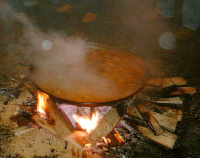
|
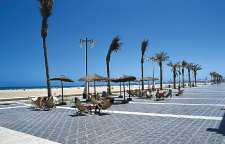 |
Valencia isn't just trees and architecture, however. The Costa Blanca, or White Coast, is one of the most popular beach getaways in all of Europe during the summer. Not only are there sugar-white beaches and sparkling blue water, there are charming cafes and restaurants where you can taste real Spanish tapas. |
|
This city isn't just beautiful and temperate, but exciting as well. At the many discos and dance clubs (for Mojitos head for (Johny Maracas) in Valencia, residents and tourists alike dance, and sometimes drink, from dusk until dawn. If you can keep up, Valencia's night spots, especially in the Barrio Carmen, are lots of fun and a definite draw for university students and adults seeking a great time after the sun goes down. |
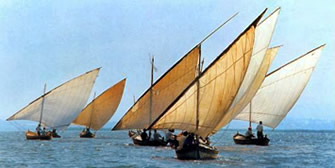
|
Parts of this text were copied from 
Conference Venue
The actual conference building
 
|
Game-On'2008 will be held at the UPV (Universidad Politecnica de Valencia) and especially at FIV. On the UPV interactive map it is building 1E (completely to the left, near a roundabout). FIV Facultat d'Informà tica Camà de Vera, s/n 46022 Valencia, Spain  Tel: +34 963877204 Tel: +34 963877204 Fax: +34 963877205 Fax: +34 963877205 E-mail: int_fi@upvnet.upv.es E-mail: int_fi@upvnet.upv.esInternet access information at the site can be found here. |
How to get to Valencia 
By Plane |
You will arrive by plane in Valencia at Valencia Manises Airport, which is located 8,5 km outside Valencia. There are direct flights to and from Valencia, international airport to Brussels - Frankfurt – Lisbon – London – Milan – Paris - Zurich. An air shuttle to Madrid and Barcelona ensures easy connection to all other destinations around the world. From the airport you can take a taxi, an aerobus, bus or metro to the centre of Valencia.
|
||
By Train
|
|
||
By Boat |
The major company linking Valencia to other seaports in the Mediterranean all year round is Trasmediterranea. You will find their Valencia information here: |
||
By Metro
|
The Metro Network in Valencia is excellent, but not too helpful for small scale travel. It does not go anywhere in the centre, for example (that has to do with the consistency of the soil in the centre), and it tends to skip other important destinations, such as Canovas and the City of Arts and Sciences. So it is most useful when you need to cover a long distance. In particular, it is the best way to get to the beach and to the university. The metro will also get you to many destinations around Valencia, beyond the city limits. The metro costs 1.20 € fixed fee, to any destination within the city limits. The metro also goes way beyond Valencia, at an extra charge. You can download the metro map here with zones and here without zones but more geographically correct. |
||
By Bus
|
Valencia bus station is situated to the west of the city, about 20 minutes from universities. From the bus station there are bus, tube (100 meters) and taxi. |
||
By Taxi |
You will find the taxis opposite arrivals at the airport.
|
||
By Car |
Use the A-7 del mediterraneo A7 Mediterranean Motorway |
||
On Foot
|
A detailed description will be given later from the tramstop to the actual building at the university and from the different bus stops. |
Detailed Map of Valencia

Useful Links







